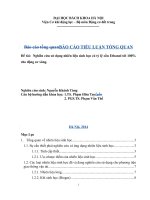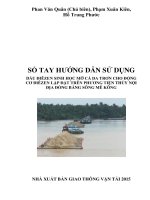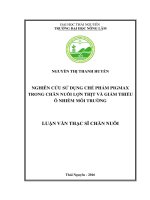Nghiên cứu sử dụng dầu diesel sinh học từ mỡ cá da trơn cho động cơ của phương tiện khai thác thủy sản tt tiếng anh
Bạn đang xem bản rút gọn của tài liệu. Xem và tải ngay bản đầy đủ của tài liệu tại đây (1.11 MB, 37 trang )
MINISTRY OF EDUCATION AND TRAINING
NHA TRANG UNIVERSITY
______________________________________
HO TRUNG PHUOC
RESEARCH TO USE CATFISH FAT
BIODIESEL FOR DIESEL ENGINES OF
FISHING SHIP
Mayor: Mechanical Power Engineering
Major code: 9520116
DOCTORAL DISSERTATION SUMMARY
KHANH HOA - 2019
Research was accomplished at Nha Trang university
Supervisor:
Prof. Phan Van Quan
Prof. Tran Gia Thai
Reviewer 1: Prof. Vu Ngoc Khiem
Reviewer 2: Prof. Nguyen Hoang Vu
Reviewer 3: Prof. Nguyen Le Duy Khai
Thesis title: “Research to Use Catfish Fat Biodiesel for
Diesel Engines of Fishing Ship”.
Mayor:
Mechanical Power
Major code:
Engineering
PhD Cadidate:
9520116
Supervisor:
Ho Trung Phuoc
Prof. Phan Van Quan
Education
Prof. Tran Gia Thai
Institution:
Nha Trang University
Key Findings:
(1) Defined some properties of B5, B10, B100 fuel
(catfish fat biodiesel) used to research.
(2) The thesis used KIVA-3V software to build and
adjust the Cummins NTA 855 engine simulation model,
which used to investigate the effect of fuel on some
thermodynamic parameters in combustion chamber,
NOx, PM emissions and some cycle parameters of
engine when using B10 fuel.
(3) Estimate the influence of B10 fuel on some
basic operating parameters of Cummins NTA 855
engine by experiment and promote a suitable fuel mixing
technology for diesel engines of fishing ship.
PhD Cadidate
Ho Trung Phuoc
INTRODUCTION
1. THE RATIONALE
Use biofuels as alternative fuel have been in the
countries research, application. Currently, in the United
States, United Kingdom, Denmark, Netherlands and
some other European countries (EU) had to use
successfully biofuels for engines in the industry and
transport.
In Vietnam, if using catfish fat biodiesel produced
for fishing ship will save a large amount of foreign
currency for the country and reduced environmental
pollution. So "Research to use catfish fat biodiesel for
engines of fishing ship" is very urgent in present context.
2. RESEARCH OBJECTIVES
Research of the effect of catfish fat biodiesel (B10)
mixture fuel on the main parameters of diesel engine of
fishing ship, shown possibility to use B10 and design
suitable adaptive fuel system.
3. RESEARCH OBJECTS AND SCOPE
3.1. Research objects
Catfish fat biodiesel and the main parameters of
diesel engine of fishing ship.
1
3.2. Research scope
- Catfish fat biodiesel B10 (10% Biodiesel B100,
90% Diesel).
- Power, specific fuel consumption, exhaust
emission of diesel engine used of fishing ship when
using B10 and DO.
4. RESEARCH CONTENTS
- Overview and theoretical studies using catfish fat
biodiesel B10 as fuel for diesel engines;
- Select the mathematical model and simulate of the
effect of B10 fuel on the main parameters of diesel
engine of fishing ship;
- Determined the main parameters of diesel engine
using B10 fuel.
5.
THE
MEANING
OF
SCIENCE
AND
PRACTICAL OF THESIS
5.1. The meaning of science
- Building a theoretical basis of the effect of catfish
fat biodiesel fuel on the main parameters of diesel
engines;
- Determined of adjusting parameters of catfish fat
biodiesel fuel to simulation: heat, viscosity and density;
2
- Show results of experiment study to use B10 fuel
on diesel engines.
5.2. The practical meaning
- Suggestion solutions to use B10 mixed fuel for
diesel engines;
- Suggestion technology of adaptive fuel system to
use B10 mixed fuel;
- Complete the manual using biodiesel exactly,
prevent spoiled of engine.
6. RESEARCH METHODS
6.1. Study of theory
- Theories study of fuel injection, mixture
formation and combustion in diesel engines using
biodiesel fuel;
- Analysis and selection of rational mathematical
models, applied to study the change of working
parameters of diesel engines using B10 fuel;
- Simulation of the effects of B10 fuel on the main
parameters of diesel fishing ship.
6.2. Experimental study
- Determine the thermal parameters of B10 fuel;
- Determine the main parameters of diesel engine
when using B10.
3
7. THESIS STRUCTURE
The thesis includes 4 chapters and conclusions,
recommendation part:
Chapter 1. Overview.
Chapter 2. Theoretical basis and mathematical
model describing the effect of biodiesel fuel on main
working parameters of diesel engines
Chapter 3. Evaluate working parameters of diesel
engine when using B10 fuel by numerical simulation.
Chapter 4. Experiment research to use catfish fat
biodiesel fuel for Cummins NTA855 engine of fishing
ship.
Conclusions and recommendations.
8. LIMITATIONS OF THESIS
The thesis has not researched the effect of the rule
of fuel supply, experiment to measure NOx and soot
emissions of diesel engine when using catfish fat
biodiesel.
4
Chapter 1. Overview
1.1. Overview of biofuels and biodiesel
Biofuels made from vegetable oils and animal fats,
which have a potential as alternative fuel for traditional
fuels. Have function addition oxygen for combustion
process, decrease exhaust emissions, blend easy with
traditional fuels and a renewable source of fuel. Biofuels
such as biogasoline, biodiesel and biogas, where only
biogasoline and biodiesel are interested to research
application for internal combustion engines.
In 2007, Vietnam has issued technical commitTCVN 7717: 2007 (table 1.1) with 20 basic technical
parameter of Biodiesel B100 and become one of the
countries is development biofuels.
Table 1.1. The basic technical parameter of
Biodiesel B100 follow TCVN 7717
Parameter
Terms of ester, min
Density at 150C, kg/m3
Flash point, 0C, min
Water and sedimentation, % volume
max
Kinematic viscosity at 400C, cSt
Ash, sulphate, % mass, max
Sulfur, % mass, ppm, max
Copper corrosion
Cetan number, min
Carbon sedimentation, % mass,
max
Acid, mgKOH/g, max
Temperature of distillation, 90%
max
Na and Ka, mg/kg, max
5
Level
96,5
860-900
13,0
Test method
EN 14103
TCVN 6594
TCVN 2693
0,05
ASTM D2709
1,9-6
0,02
0,05
No1
47
TCVN 3171
TCVN 2689
ASTM D5453
TCVN 2694
TCVN 7630
0,05
ASTM D4530
120
EN 1411
360
ASTM D1160
5,0
EN 1408
Based on TCVN 7717: 2007, in 2009, Vietnam
issued national technical regulation of gasoline, diesel
fuel (DO) and biofuel - NTR 1: 2009 / Ministry of
science and technology (MOSAT) with 11 basic
technical parameter of biodiesel B100 (Table 1.2).
Table 1.2. The basic technical parameter of
Biodiesel B100 follow NTR 1: 2009 / MOSAT
Parameter
Terms of ester (FAME), %
mass
Water and sedimentation, %
volume
Kinematic viscosity at 400C,
mm2/s
Ash, sulphate, % mass
Level
96,5
Test method
TCVN 7868
(EN 14103)
0,050
TCVN 7757
(ASTM D 2709)
1,9 – TCVN 3171
6,0
(ASTM D 445)
0,020
TCVN 2689
(ASTM D 874)
0,05
TCVN 7760
(ASTM D 5453)
47
TCVN 7630
(ASTM D 613)
0,50
TCVN 6325
(ASTM D 664)
6
TCVN 7895
(EN 14112)
0,020
TCVN 7867
(ASTM D 6584)
0,240
TCVN 7867
(ASTM D 6584)
0,001
TCVN 7866
(ASTM D 4951)
Sulfur, % mass
Cetan number
Acid, mgKOH/g
Oxidation stability at 1100C, h
free glycerin, % mass
Total glycerin, % mass
Phospho, % mass
6
1.2. Base diesel engine selection as the main engine
for research
With a large marine area and river in the southwest
of Vietnam, the number of fishing ship is very great.
Base diesel engine selection as the main engine for
research as according to the popular level of engines,
where diesel engine of Cummins, Yanmar and
Mitsubishi engines is popula. This study the thesis
choose Cummins NTA855 engine as the main engine for
research.
1.3. Conclusion of Chapter 1
Chapter 1 had shows the following content:
- Vietnam had geographic advantages to develop
fisheries, which is an important factor to produce
biodiesel production from fish fat.
- Biodiesel fuel used for diesel engines of fishing ship
will decrease environmental pollution and develop
economical of fisheries in Vietnam.
- Research catfish fat biodiesel will contribute to the
additional fuel for diesel engines, including diesel
engines of fishing ship.
7
Chapter 2. THEORETICAL BASIS AND
MATHEMATICAL MODEL DESCRIBING THE
EFFECT OF BIODIESEL FUEL ON MAIN
WORKING PARAMETERS OF DIESEL
ENGINES
2.1. Main working parameters of diesel engine
Main working parameters of diesel engine include:
Power, efficiency, specific fuel consumption and
exhaust emissions. where, the maximum combustion
pressure (pz) and the exhaust gas temperature (Tx)
represent the mechanical and thermal loads of engine.
Fuel combustion process in diesel engine shown in
Figure 2.1.
Figure 2.1. Pressure p, rate of fuel injection mf, heat
release rate Qn
8
2.2. Fuel for diesel engine
Follow the theory of fuel, fuel for diesel engines
must be satisfied The following conditions:
- Must have a large mass in nature to provide long-term
use;
- Great heating;
- Combustion products have little effects on the
environment, especially humans;
- Use easy and safe transport;
- Technology suitable.
Traditional Diesel Fuel is a product from
petroleum, biodiesel fuel from fish fat is a product has
low carbon content, less sulfur, more oxygen and reduce
the exhaust emission than diesel fuel.
2.3. The effect of B10 fuel on main working
parameters of diesel engine
The effect of biodiesel fuel properties from fish fat
on main parameters of diesel engines is injection
process, mixture formation and combustion process such
as viscosity, cetance number, heat, surface tension and
evaporation:
- The heat of the fuel determines the output heat of
the cycle and effects on the main parameters of engine;
9
- The structure of spray depends on the physical
properties of the fuel especially: viscosity, surface
tension and density.
This structure of spray determines the quality of
combustion mixture formation process and effect on
main parameters of diesel engines. Heat release rate
calculate follow formula 2.1.
m
SOC
CD
SOC a
dQf
Qf ,total a(m 1)
e
d
CD
m 1
(2.1)
Here, a, m: coefficient of Vibe equation, φSOC: angle of
start oil combustion; φCD: combustion duration (0CA); φ:
φSOC <φ <φSOC + ΔφCD; Qf,total: heat of fuel.
Specific fuel consumption (Sfc) show economical
parameters of diesel engines given by the follow
formula:
Sfc
A h .Cd
A .C
. 2l (pinj pc ) h d . 2l .p
Ne
Ne
(2.2)
Where, Ne: power; ρf: fuel density; Ah: area of hole;
Cd: discharge coefficient of the nozzle; Sfc: specific fuel
consumption.
10
2.4. Conclusion of Chapter 2
Chapter 2 had analysis and shown follow content:
- The structure of spray depends on the physical
properties of fuel (viscosity, density, surface tension).
This structure determines the quality of the combustion
mixture formation, combustion process and affects the
main working parameters of diesel engine.
- Based on theoretical analysis and mathematical
models related to the fuel properties presented, the basic
mathematical models in Chapter 2 will used to simulate
the combustion and emission formation of engine when
using catfish fat biodiesel fuel.
11
Chapter 3. EVALUATE WORKING
PARAMETERS OF DIESEL ENGINE WHEN
USING B10 FUEL BY NUMERICAL
SIMULATION
3.1. Simulation method in engine
Simulation method in engine help to research
improving performance of internal combustion engine.
The main advantages of simulation method:
- It is possible to easily change all parameters to
study.
- It is possible to impose initial conditions on a
large range.
- It is possible to study the individual processes in
the total combustion process.
- Can extract relevant information in detail at all
times.
- High efficiency in terms of time and cost.
3.2. Simulation of Cummins NTA855 engine using
BIO fuel from catfish fat
CFD software code KIVA - 3V developed over the
years at the Los Alamos National Laboratory (LANL),
America. That is an open-source software use fortran
12
programming language to simulation 2D and 3D
turbulent flow with chemical reaction such as simulating
combustion process of internal combustion engines.
The main steps for CFD solving related multi phase flow and chemical reactions using CFD code
KIVA -3V including:
- Build the geometry model of combustion
chamber and discrete geometry model into finite volume
model (meshing);
- Determine the government differential equations;
- Determine the input and boundary conditions,
choose the mathematical model, solvingand post –
processing.
Conservation of mass equation:
m (m u i )
(m / ) s
c
D
m m
t
x i
x i
x i
(3.1)
Conservation of momentum equation:
(u j )
t
1 p
u i u j ij 2
x i
x j
2 k
F g j A 0
3 x i
s
j
13
, j = 1,2,3
(3.2)
Conservation of energy equation:
T T
2T
c p
k 2
x i
t x i
(m / )
s
c
D hm
A 0 Q Q
x i
x i
m
(3.3)
The mesh model shown in Figure 3.1.
a) Axonometric view
b) View from top
Figure 3.1. Simulation mesh model of champer
Cummins NTA855 engine
3.3. Simulation results
Spray
and
combustion
mixture
Formation:
compare structure of B10 and DO spray at 1200 rpm,
shown in Figure 3.2. That are similar.
14
Timming 150BTDC
Timming 130BTDC
(after injection 30CA)
(after injection 50CA)
Figure 3.2. Spray structure B10 and DO fuel
in champer
Change combustion pressure in cylinder: Figure
3.3 shows combustion pressure. Fig. 3.4, Fig 3.5 shows
Pressure (bar)
power and specific fuel consumption.
Speed: 1200 (rpm)
Crank angle (deg)
Figure 3.3. Pressure in the cylinder of B10 and DO fuel
15
Power (kW)
Speed (rpm)
Specific fuel consumption (g/kW.h)
Figure 3.4. Power of B10 and DO fuel
Speed (rpm)
Figure 3.5. Specific fuel consumption of B10 and DO fuel
Change temperature and heat of release rate: heat
of release rate of B10 and DO shown in Figure 3.6,
16
combustion temperature shown in Figure 3.7, Figure 3.8,
Heat release rate (J/độ)
Figure 3.9.
Speed: 1200 (rpm)
Crank angle (deg)
Temperature (K)
Figure 3.6. Heat release rate of B10 and DO fuel
Speed: 1200 (rpm)
Crank angle (deg)
Figure 3.7. Combustion temperature of B10 and DO fuel
17
Pressure (bar)
Temperature (K)
Tem
Pres
Speed: 1400 (rpm)
Crank angle (deg)
Figure 3.8. Combustion temperature and pressure
of B10
DO
B10
Figure 3.9. Temperature distribution of B10 and DO
fuel in chamber
Exhaust emissions: Figure 3.10 shows the NOx
emission of B10 and DO fuels, NOx emission level is
great when high combustion temperature, NOx process
formation in high temperature zone shown in Figure 3.11.
18
Speed: 1200 (rpm)
Crank angle (deg)
Figure 3.10. NOx formation of B10 and DO fuel
DO
B10
Figure 3.11. NOx distribution of B10 and DO
fuel in champer
Figure 3.12 shows the soot formation of B10 fuel
and DO, Figure 3.13 shown. distributes of soot in
combustion chamber.
19
Speed: 1200 (rpm)
Crank angle (deg)
Figure 3.12. Soot formation of B10 and DO fuel
DO
B10
Figure 3.13. Soot distribution of B10 and DO
fuel in champer
3.4. Conclusion of chapter 3
The simulation results show the effect of catfish fat
biodiesel fuel on combustion pressure, temperature,
power, specific fuel consumption and emission of diesel
engine. Where, main working parameters of diesel
engine when using B10 equivalent with DO fuel.
20
Chapter 4. EXPERIMENT RESEARCH TO USE
CATFISH FAT BIODIESEL FUEL FOR
CUMMINS NTA855 ENGINE OF FISHING SHIP
4.1. Blending method
On line blending method on pipe to determine the
ratio between B100 and DO shown in Figure 4.1.
B100
Tank
Control flow
Control
blending
DO
Tank
To engine
Control flow
Figure 4.1. On Line Blending method
The fuel tanks of the blending system for Cummins
NTA855 engine shown in Figure 4.2.
21









